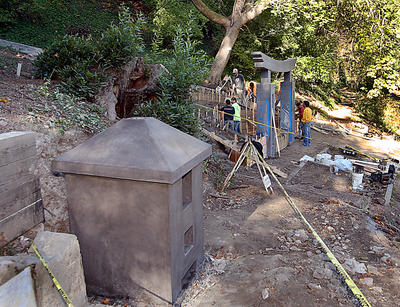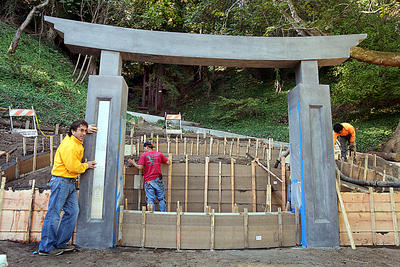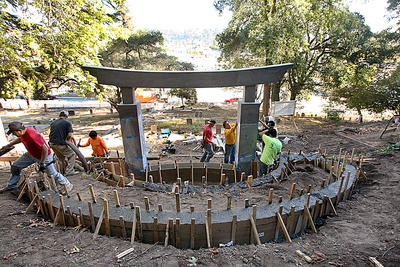
SANTA CRUZ -- Chinese fishermen, railroad workers, servants and farm laborers once drove the county's economy, but little trace of their history exists.
Until now.
Construction workers finished the first phase of a 17-foot Chinese memorial gate at Evergreen Cemetery Thursday.
The gate, commissioned by the Santa Cruz Museum of Art & History, will be part of the museum's sold-out Chinatown history walk Saturday.
Contractor Tom Ralston collaborated with local historians Sandy Lydon and Geoffrey Dunn, former Chinatown resident George Ow, and museum volunteer Sibley Simon to design the gate.

The gate is located in the Chinese section of the cemetery, next to an oven, where the deceased's personal belongings were burned to symbolically send them to the afterlife. The Chinese graves were marked with wooden headstones, meant to be temporary, so that family could eventually dig up the bones and send them to China.
Simon, who leads the museum's efforts to restore the cemetery, said that the cemetery seems a natural place to highlight the story of Santa Cruz's early Chinese immigrants.
"This cemetery is really the only place I know of, certainly in Santa Cruz, that Chinese immigrants used and still remains," Simon said.
Santa Cruz once had four Chinatowns, and the only remnant is a commemorative plaque that Dunn installed in the Galleria building on Front Street, where the last Chinatown stood.
Ow, whose private donation funded the project, lived in that neighborhood from 1943 to 1948, before it was wiped out by a flood in 1955. Ow said that this memorial gate represents an offering to the forgotten Chinese spirits that roam the hills.

Lydon said that Santa Cruz's Chinese population was small compared to Monterey and Watsonville, because the city had the strongest anti-Chinese sentiment in the state.
He compared the presence of Chinese history in Santa Cruz to a watermark. "When you hold up a page of our history, you won't see them necessarily in the print on the page, but you'll see them within the paper as a watermark," said Lydon. "They were such a part of making this place what it was."
"They're there within the pages of history, you just have to learn how to hold the paper up and look."
Follow Sentinel reporter Kara Guzman at Twitter.com/Karambutan
IF YOU GO
Chinatown is in the Heart
WHAT: Pop-up history museum featuring Santa Cruz's Chinatowns
WHERE: Comerica Bank parking lot, 25 River St., Santa Cruz
WHEN: Noon to 2 p.m. Saturday
COST: Free
Details: www.santacruzmah.org/event/pop-up-museum-chinatown-is-in-the-heart/